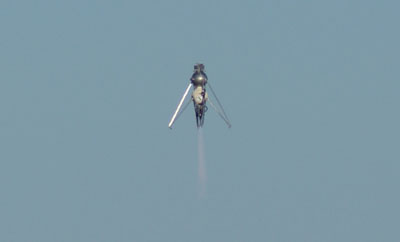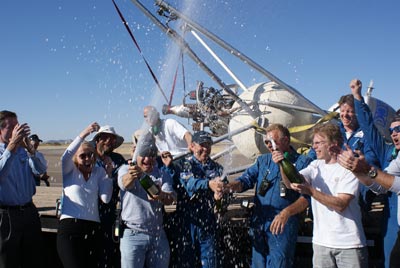Dueling Murphyby Jeff Foust
|
| That the event took place at all this year was an accomplishment itself after classified activities at Holloman forced the X Prize Foundation to seek an alternative location on short notice. |
Moreover, this time around there was more pressure on Armadillo to win the event. Part of that was based on Armadillo’s accomplishments and its growing profile, including an agreement with the Rocket Racing League (RRL) to develop rocket engines that will be used on the RRL’s aircraft. However, there was some outside pressure on Armadillo as well, in the form of competition: this year’s event would, for the first time, have a competing team fly its vehicle in an effort to win the Level 1 prize.
The LLC started on a chilly Friday morning with Armadillo taking its Mod vehicle out to the pads in a bid to win the Level 1 challenge. At first, everything seemed to go well, other than a late departure from the staging area. On cue, the Mod lifted off from one pad, translated the 100 meters over the other pad, and descended. There was only one problem: the lander descended too quickly and touched down before the required 90 seconds were up.
Armadillo team leader John Carmack said a late change to the operation of the engine was to blame. “AST’s [FAA Office of Commercial Space Transportation] analysis of the maximum range this vehicle could reach in abort conditions had forced us to turn down the operating pressure of the vehicle,” decreasing the engine’s thrust, he explained in a brief press conference after the morning flight attempt. “It’s turned down so far that we really can’t kill much velocity at all. So the first flight over there, descending nominally, I throttled all the way up and couldn’t quite kill all the velocity. So we touched down, came back up; everything was fine but we knew we were already disqualified on that flight leg.”
Since the vehicle wasn’t damaged, Armadillo hurried to try and get two qualifying flight legs in before the two-and-a-half-hour window closed. The second flight was a success, with the vehicle descending slowly enough to remain in the air for the required 90 seconds. Armadillo still had plenty of time—over an hour—to get the third flight in and return the vehicle to the starting line.
That’s when they ran into another problem having nothing to do with their vehicle itself. In order to hold the LLC at an active airport, the airport and the FAA agreed to close the airspace above the airport for 90-minute blocks. LLC flights could only take place within those periods, of which there were three each day, at fixed times. The LLC competition periods were supposed to be timed so that the 90-minute airspace closures took place in the middle of the 150-minute competition windows. However, since the first period started late (because of “administrative delays”, according to Carmack), the FAA airspace window was coming to a close with plenty of time left on the LLC clock.
Armadillo hurried to try to get a third flight off before the FAA window closed, but the clock ran out before they could get the vehicle ready; requests to extend the window by just 10 minutes were turned down by the FAA. “Color me quite frustrated on several counts there,” Carmack said. “This flight would have been successful if we hadn’t had to detune the engine for AST’s analysis. Or, we could have done the third flight right there if the flight window hadn’t been closed.” Murphy, it appeared, had struck again.
At the end of the morning flight window it appeared that Armadillo would have to start over in its next flight opportunity in the afternoon. However, at midday the team got a break. The contest judges ruled that the closure of the FAA flight window did not mark the end of the contest window: instead, it was an external event that put the contest window on hold. When the next FAA flight window opened in the afternoon, Armadillo could pick up where it left off, using the remaining time in that contest window—about an hour—to make just one flight and return to the staging area. If Armadillo could do that, it would win Level 1 of the LLC.
| “You know, after you’ve done these a few times, it is just another flight,” Carmack said after winning the Level 1 prize. |
That was just the break Armadillo needed. Friday afternoon, in front of an audience that included New Mexico Governor Bill Richardson (who was at the airport for a press conference about a joint venture involving Armadillo and Rocket Racing Inc.), the Mod lifted off the pad and performed its return flight, landing safely. A short time later, the Armadillo team received a hero’s welcome when they and their vehicle arrived back at the staging area, officially winning first place in the Level 1 LLC and $350,000 in prize money from NASA.
After champagne was sprayed and congratulations handed out, Carmack played down the accomplishment a bit. “You know, after you’ve done these a few times, it is just another flight,” he said. “We have this big celebration at the end here because we finally strung two of them together, but we’ve done this a whole bunch of times now, and it’s not going to become what we want it to be until we’re doing this multiple times every day.”
 Armadillo Aerospace’s Mod vehicle in flight during the Lunar Lander Challenge on October 24. (credit: J. Foust) |
Murphy’s revenge
The final Mod flight on Friday was not completely trouble-free: it took a couple of attempts to get the engine started. Carmack said after the flight that the problem was linked to a slow-opening valve, a problem that his team knew about going in. The problem didn’t prevent the engine from finally starting, though, and he added, “It doesn’t appear to be a problem with Pixel, so we don’t expect it to be a be a problem tomorrow.”
Pixel was the other vehicle that Armadillo brought to the event to compete for Level 2, which requires remaining aloft for 180 seconds and landing on a pad with simulated lunar terrain. On Saturday morning—right on schedule, mindful of the strict FAA airspace windows—Armadillo hauled Pixel out to the pad for their first-ever attempt to win Level 2.
The result was anticlimactic. Rather than gracefully lift off, the vehicle tumbled over on its side, kicking up a cloud of dust. Pixel did not appear seriously damaged, and initial indications were that Armadillo would make repairs, including replacing the vehicle’s engine, and try again in the afternoon. However, even before the morning window officially closed, Armadillo indicated they would not make another Level 2 flight attempt that day, ending the 2008 Lunar Lander Challenge.
| “It’s not too bad,” Carmack said of failing to win Level 2. “I would have been really bummed if we didn’t wind up doing anything out here, but we got the Level 1 out there.” |
Carmack explained in an interview that the problem was related to the valve issue seen in Mod’s last flight Friday. During testing leading up to the 2008 LLC, the team had noticed that, under some conditions, the fuel valve would open sluggishly. “We had it happen a half-dozen times during testing, and we tried to track it down, but we did not get to the bottom of it,” he said. They changed out some parts, which seemed to solve the problem during their last set of tests before the event. “It’s never good to have a problem just vanish and not really know what you did, but we thought it was good enough to fly.”
During Pixel’s flight attempt, the liquid oxygen valve moved to full throttle normally, but the fuel valve moved at only half-speed. That not only created a lean, hot mixture of propellants, it also reduced the amount of fuel available for film cooling of the nozzle. “So it was both hotter and less shielded there, and it burned through part of the nozzle,” causing the vehicle to tip over.
The mystery about the cause of the valve problem caused Armadillo to decide not to fly Pixel again that day, even though it would have been possible to fix it in time. “The bottom line was that we’ve been looking at this problem for the last two weeks and we know we need to get to the bottom of this,” he said. “It’s probably better for us to stop and not fly anything again until we’ve absolutely found this problem.”
Carmack, though, wasn’t that disappointed about not winning Level 2 after finally capturing Level 1. “It’s not too bad,” he said. “I would have been really bummed if we didn’t wind up doing anything out here, but we got the Level 1 out there… Today turned out to be just another day of testing for us.”
Competition and the future
And what about Armadillo’s competition? For the first time in the three-year history of the LLC, a team other than Armadillo flew a vehicle. TrueZer0 (spelled with the numeral “0” in place of the letter “o”), a four-person team based in the Chicago area, developed a hydrogen peroxide-powered vehicle this year to compete in Level 1. However, while Ignignokt—named after a character in the animated series Aqua Teen Hunger Force—had performed an extensive series of ground and tether tests, the vehicle had never performed a free flight of any kind prior to the LLC, let alone fly a full flight profile.
The outcome was predictable, if unfortunate. Ignignokt rose smoothly from the launch pad but within seconds started spinning uncontrollably. The team had no option but to hit the abort button, shutting down the engine and causing the vehicle to fall to the ground, releasing a plume of peroxide.
“The vehicle is basically a total loss at this point,” said Scott Zeeb of TrueZer0. “It really wasn’t designed to take anything like that, obviously.” Still, the flight was a major accomplishment for a team that started work only 10 months ago and spent what they estimated to be $10,000 on hardware and other materials.
TrueZer0 seems willing to return next year, and they may be joined by some other teams that have been working on vehicles but didn’t have them ready for the 2008 LLC, from the father-and-son Unreasonable Rocket to NewSpace startup Masten Space Systems. Armadillo will likely make another stab at Level 2 next year as well.
Peter Diamandis, chairman and CEO of the X Prize Foundation, hinted in closing comments Saturday that next year’s competition might be held sooner than next October, addressing a concern Armadillo in particular has had with the once-a-year competition format. “I feel like a game show host,” he said, when he congratulated Armadillo for winning the $350,000 Level 1 prize. “And we hope you return next time to go for the million-dollar award,” the value of winning first place in Level 2.
Armadillo and other teams will be back next year. And so will Murphy.
